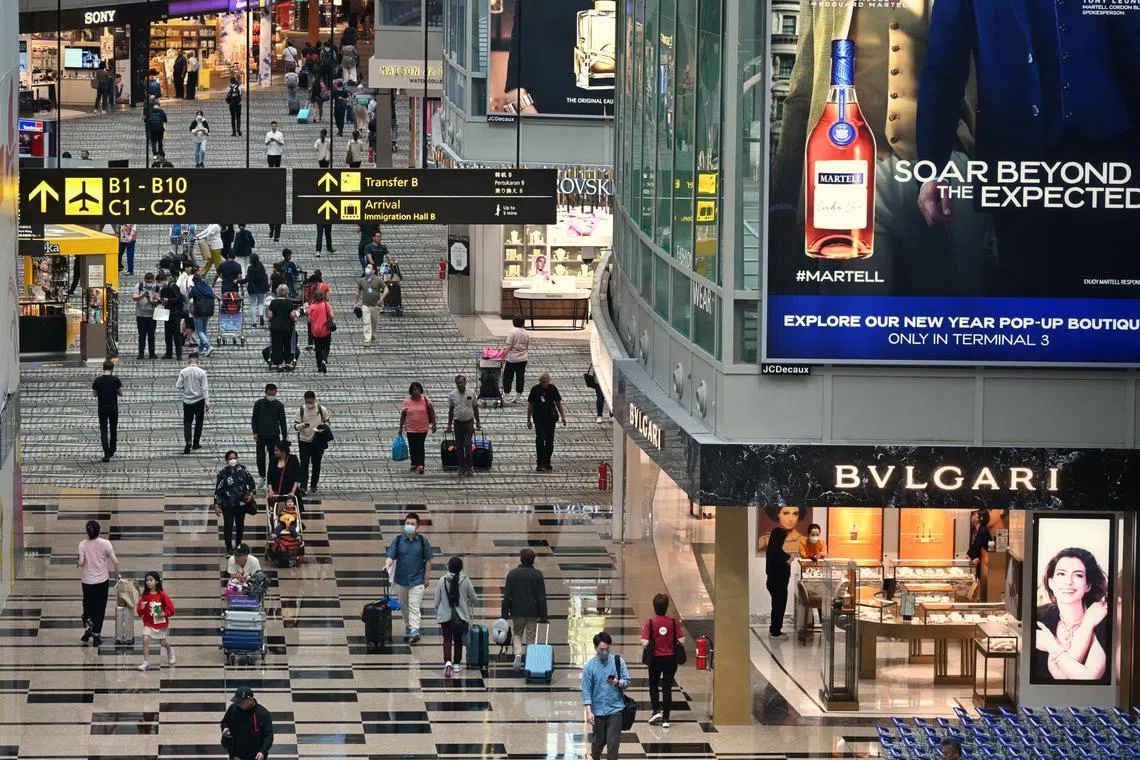Changi ranks 9th among world’s busiest airports in 2022 for international passengers
Sign up now: Get ST's newsletters delivered to your inbox

Changi Airport was the world’s 9th busiest, with a total of 31.9 million travellers passing through in 2022, according to the ranking by ACI World.
ST PHOTO: CHONG JUN LIANG
Michelle Ng
Follow topic:
SINGAPORE – Changi Airport has returned to the ranks of the world’s top 10 busiest airports, in terms of international passenger traffic in 2022, amid strong growth in air travel demand.
The airport was the world’s ninth busiest, with a total of 31.9 million travellers passing through, according to the ranking by Airports Council International (ACI) World released last Wednesday.
Dubai International Airport held on to the top spot with 66 million international passenger movements, followed by London Heathrow Airport with 58.2 million passengers, and Amsterdam Airport Schiphol with 52.5 million.
Before the Covid-19 pandemic, Changi Airport was the world’s seventh busiest in terms of international passenger traffic and managed a record 68.3 million passenger movements in 2019.
The airport dropped to the 95th spot in 2021 as borders were shut and air travel demand plunged during the pandemic.
With the resumption of international travel, global passenger traffic in 2022 reached close to seven billion, based on preliminary figures from ACI World.
It represents an increase of 53.5 per cent from 2021, or a 73.8 per cent recovery from 2019 results, marking an important milestone in air travel’s recovery from the pandemic.
International traffic is inching back to pre-pandemic levels, with volumes climbing 89.7 per cent in February 2023 compared with February 2022, according to figures from the International Air Transport Association (Iata) released last Tuesday.
In February, all markets recorded strong growth, led by carriers in the Asia-Pacific region, said Iata.
International traffic, measured in revenue passenger kilometres, reached 77.5 per cent of February 2019 levels.
Iata director-general Willie Walsh said demand for air travel continues to be strong across the globe and particularly in the Asia-Pacific, despite the uncertain economic climate.
“The industry is now just about 15 per cent below 2019 levels of demand and that gap is narrowing each month,” he said.
“People are flying in ever greater numbers. With the Easter and Passover holidays, we are expecting large numbers of travellers to take to the skies in many parts of the world. They should do so with confidence that airlines have been rebuilding resiliency that suffered owing to the pandemic,” added Mr Walsh.
Mr Shukor Yusof, founder of aviation consultancy Endau Analytics, said Changi’s return to the top 10 of the world’s busiest airports is a clear sign that it is “slowly restoring its position as a pre-eminent air hub in the region”.
“Additionally, it means this is an airport that provides excellent services for transit and for visitors arriving in and departing from Singapore,” he added.
Mr Mohshin Aziz, director of Pangolin Aviation Recovery Fund, which invests in aviation businesses, noted that many of Changi’s key destinations such as China, Hong Kong, Taiwan, Japan and South Korea had yet to fully open their borders in 2022. These destinations made up around a quarter of Changi’s route network in 2019.
“The good news is these countries have finally embraced reopening and carriers are quickly recommencing flights. I am certain that by the end of 2023, Changi’s ranking will climb by a notch or two,” he said.
OAG Aviation’s head of Asia Mayur Patel attributed Singapore’s strong performance to being one of the early Asian countries to reopen in early April 2022, and to the establishment of vaccinated travel lanes prior to that. However, he predicted that the rapid rise of Hong Kong’s air capacity and hub development could outpace Singapore in the next 12 to 18 months.
Passenger traffic volumes, flights and city links at Changi are now at about 80 per cent of pre-Covid-19 levels, Transport Minister S. Iswaran said in March, adding that Changi’s passenger traffic should return to pre-pandemic levels by 2024,
Mr Patel expects Changi to hit 90 per cent in these areas in the months to come, with more flights being added to destinations such as China, Japan, South Korea and Taiwan.
“However, the remaining 10 per cent of the recovery to 2019 levels will take some time, factoring in supply chain issues relating to aircraft delivery... and bilateral arrangements where frequencies to certain city pairs have become restrictive, such as the Singapore-Jakarta route,” he said.

